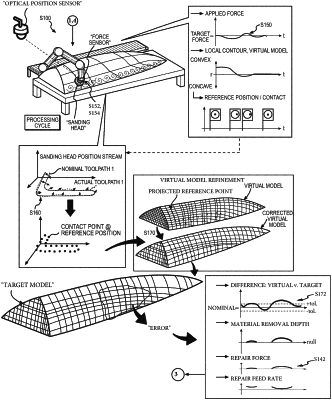| CPC B25J 9/1653 (2013.01) [B24B 51/00 (2013.01); B25J 9/163 (2013.01); B25J 9/1664 (2013.01); B25J 9/1679 (2013.01); B25J 9/1697 (2013.01); B25J 11/0065 (2013.01); B25J 13/085 (2013.01); G06T 1/0014 (2013.01); G06T 7/13 (2017.01); G06T 7/60 (2013.01); G06T 19/00 (2013.01); G06T 2207/10024 (2013.01); G06T 2219/004 (2013.01)] | 20 Claims |

|
1. A method comprising:
during a processing cycle:
navigating a sanding head across a first workpiece region of a workpiece according to a first toolpath; and
based on a first sequence of force values output by a force sensor coupled to the sanding head, deviating the sanding head from the first toolpath to maintain forces of the sanding head on the workpiece region proximal a first target force;
detecting a first sequence of positions of the sanding head traversing the workpiece region;
interpreting a first surface contour of the first workpiece region based on the first sequence of positions;
detecting a first difference between the first surface contour and a first target surface, corresponding to the first workpiece region, defined in a target model of the workpiece;
generating a second toolpath for the first workpiece region based on the difference; and
during a correction cycle:
navigating the sanding head across the first workpiece region according to the second toolpath to reduce the difference.
|